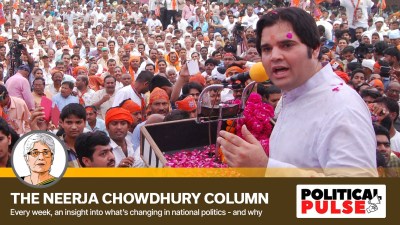- India
- International
Harvest of motifs: A 35-year-old school gets an artistic makeover
It indeed reaffirmed what economist EF Schumacher said of an “entirely new system of thought, a system based on attention to people, and not to goods”.
 The walls of Little Ones Public School in Delhi painted in myriad hues.
The walls of Little Ones Public School in Delhi painted in myriad hues.
When green elephants walk on the walls and red and ochre peacocks dance, why would any child not want to be there? At the Little Ones Public School (LOPS) in Said-ul-Ajab, New Delhi, a makeover has turned the 35-year-old space into a showstopper. While for architects Vandini Mehta and Rohit Raj Mehndiratta of Studio Vanro, it was only an external change to bring Jharkhand’s Sohrai folk art on the walls, for the teachers and students it has prompted a harvest of ideas and motives.
When Mehta visited the school in December last year, she saw pale yellow walls and 10×8 ft classrooms that barely fit 20 children. Though the 4,000 sq ft school hosts children up to class eight, the tiny cabin-like spaces couldn’t possibly tolerate structural changes. It started with a typical two-room house and a cow shed. Even today, all around are taller buildings, though the school continues to have an open space for various activities for children. “While the school didn’t see much potential in the limited area, I figured one could optimise the space more efficiently. There is an almost magical and inspiring energy about the place. Initially, we planned only to paint the walls and renovate the toilets. Then the space began opening up. There was clutter that could be done away with and we could build a tiny play area for toddlers. We collaborated with a young team from Anthill Creations, which has worked on numerous tyre parks,” says Mehta.
While the child-friendly toilets were done during the winter break, the folk art on the walls came up in spring. Studio Vanro’s association with designer and scenographer Rajeev Sethi gave them access to folk artists from Jharkhand — Rudan Devi, Sukhiya Devi, Sajna Devi and Prakash. “They have done about seven to eight murals on the school’s corridors. Sohrai, primarily a celebration of harvest, is done on the walls in their villages. The motifs are from what they see in their everyday life and the forests around them, including crocodiles, snakes, peacocks, elephants, cows and monkeys. These artists have a strong sense of aesthetics and we discussed how we could abstract some of their pictorial frames. It was all done within three days,” says Mehndiratta.
Artist A Ramachandran, who has used folk art in numerous books for children, says, “The grammar of folk art is close to a child’s art. If you study it carefully, you will see how they pass through different stages of realism without inhibitions. Art is about living in harmony with your surroundings. Folk art has always testified to the connect people have with nature and children are not oblivious to it. Their active imagination can bring alive any idea. That’s what I tried to do in my books as well, to suggest possibilities.”
At LOPS, therefore, one sees a wall with hand prints of young children done in concentric circles, so that they feel they are a part of the project. The seniors also worked with the Studio Vanro team on the external wall. “When the school opened in the end of March, it was a sight to see the children’s reactions. One of the first to enter were four boys who simply stood in their tracks. ‘Who did this’, they asked, surprised by the transformation. Most of the parents here are daily wage labourers and maids. They looked at each wall with a sense of wonder,” says Shampa Chowdhury, Principal of LOPS, which was established in 2008.

“My father would often say ‘Make something out of nothing’. This school project seemed to have emerged from that. It is about recycling spaces and making them efficient. Technically, we haven’t built much here. This project reminded me of the relevance of space, how small changes can make a difference,” says Mehta. She recalls how the folk artists also sang as they worked, and were in sync with everything around them. The project proved that architecture doesn’t happen in isolation, collaborations are important and as a witness to life itself, song and music isn’t far away either.
It indeed reaffirmed what economist EF Schumacher said of an “entirely new system of thought, a system based on attention to people, and not to goods”.
Apr 25: Latest News
- 01
- 02
- 03
- 04
- 05



































